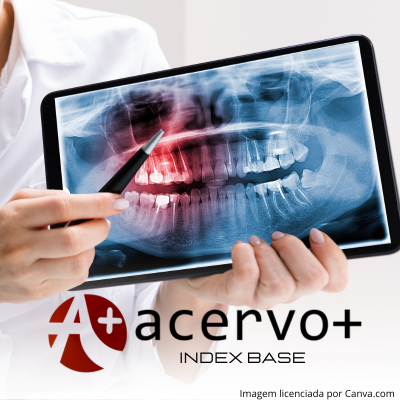Fluxo digital na rotina dos cirurgiões dentistas
##plugins.themes.bootstrap3.article.main##
Resumo
Objetivo: Realizar um levantamento do estado atual da odontologia digital na rotina dos cirurgiões dentistas do estado do Espírito Santo. Métodos: Foi enviado um questionário virtual respondido por 244 cirurgiões-dentistas (CDs), obtidos por meio de amostra por conveniência devidamente inscritos no Conselho Regional de Odontologia, seção Espírito Santo (CRO-ES). As análises foram feitas utilizando os seguintes parâmetros comparativos: especialidade e tempo de atuação. Resultados: Houve variáveis relevantes entre a presença ou não de ter uma especialidade e o uso da tecnologia na prática clínica (p=0,03). Encontrou-se diferença estatística referente à associação entre a experiência profissional por ano de formado e o fato das tecnologias digitais melhorarem a qualidade dos métodos de tratamento dos pacientes (p=0,028). Consegue-se associar a presença ou não de ter uma especialidade e diálogo com laboratório referente ao fluxo digital (p<0,01). A experiência profissional também foi associada com o diálogo com o laboratório sobre o fluxo de trabalho (p-<.001). Conclusão: Assim, fica claro que o fluxo digital está evoluindo para ser introduzido no cotidiano do paciente, porém ainda há muitas limitações, devido à falta de conhecimento e de uso dos dentistas, por isso cada vez mais há uma necessidade de dialogar com o laboratório, devido à necessidade de existir uma harmonia, a fim de qualificar o tratamento.
##plugins.themes.bootstrap3.article.details##
Copyright © | Todos os direitos reservados.
A revista detém os direitos autorais exclusivos de publicação deste artigo nos termos da lei 9610/98.
Reprodução parcial
É livre o uso de partes do texto, figuras e questionário do artigo, sendo obrigatória a citação dos autores e revista.
Reprodução total
É expressamente proibida, devendo ser autorizada pela revista.
Referências
2. BOBICH AM e MITCHELL BL. Transforming Dental Technology Education: Skills, Knowledge, and Curricular Reform. Transforming Dental Technology Education: Skills, Knowledge, and Curricular Reform, Pasadena City College, 1570 East Colorado Blvd. Pasadena, CA. 2017; 91106: 626-585-7200.
3. DAVIDOWITZ G. The Use of CAD/CAM in Dentistry. The Use of CAD/CAM in Dentistry, Dental Clinics. 2011; 55(3): 559-70.
4. DECURCIO DA, et al. Digital planning on guided endodontics technology. Brazilian Dental Journal. 2021; 32(5).
5. FUNG L, et al. Implementing Digital Dentistry into Your Esthetic Dental Practice. 2020; 64(4): 645-657.
6. GREEN J, et al. Lasers and Radiofrequency Devices in Dentistry. Lasers and Radiofrequency Devices in Dentistry, Oral and Maxillofacial Surgery. 2011; 11201.
7. GROSS D, et al. Digitalization in dentistry: ethical challenges and implications. 2019; 50(10): 830-838.
8. EATON KA.The development of digital dentistry in the UK: An overview. Primary Dental Journal. 2022; 11(4).
9. KHANNA S, el al. 3D Printed Band and Loop Space Maintainer: A Digital Game Changer in Preventive Orthodontics. Journal of Clinical Pediatric Dentistry. 2021; 45(3).
10. MARTIN CB, et al. Orthodontic scanners: What’s available? Journal of Orthodontics. 2015; 42(2).
11. MIYAZAKI T, et al. A review of dental CAD/CAM: current status and future perspectives from 20 years of experience. Hantanodai. 2008; 28(1): 44-56.
12. NIEMIEC BA. Digital Dental Radiography. San Diego. 2007; 92111(24): 3.
13. PARIZE H, et al. Digital versus conventional workflow for the fabrication of physical casts for fixed prosthodontics: A systematic review of accuracy. 2022; 128(1): 25-32.
14. REIS T, et al. 3D-Printed Teeth in Endodontics: Why, How, Problems and Future—A Narrative Review. International Journal of Environmental Research and Public Health. 2022; 19(13).
15. REKOW ED. Digital dentistry: The new state of the art — Is it disruptive or destructive? Dental Materials. 2020; 36(1).
16. RODRÍGUEZ G, et al. Influence of Cone-beam Computed Tomography in Clinical Decision Making among Specialists. Journal of Endodontics. 2017; 43(2).
17. SHAH P e CHONG BS. 3D imaging, 3D printing and 3D virtual planning in endodontics. In Clinical Oral Investigations. 2018; 22(2).
18. SHAH V. Digital Dentistry-The Future of Oral Health. 2020; 17p.
19. STANLEY M, et al. Fully digital workflow, integrating dental scan, smile design and CAD-CAM: case report. 2018; 18(1): 134.
20. SUESE K. Progress in digital dentistry: The practical use of intraoral scanners. Dental Materials Journal. 2020; 39(1).
21. SWANSON AK, et al. Digital restorative workflows for developmental dental defects in young patients: A case series. Journal of the American Dental Association. 2023; 154(4): 340-348.
22. TALLARICO M. Computerization and Digital Workflow in Medicine: Focus on Digital Dentistry. 2020; 13(9): 2172.
23. VAN DER ZANDE MM, et al. Adoption and Use of Digital Technologies among General Dental Practitioners in the Netherlands. 2023; 10(3): e0120725.
24. VANDENBERGHE B. The digital patient – Imaging science in dentistry. Journal of Dentistry. 2018; 74.
25. VAN NOORT R. The future of dental devices is digital. 2011; 28(1): 3-12.
26. WATANABE H, et al. Digital Technologies for Restorative Dentistry. In Dental Clinics of North America. 2022; 66(4).
27. ZAHARIA C, et al. Digital Dentistry - 3D Printing Applications. Journal of Interdisciplinary Medicine. 2023; 2(1): jim-0032.

